Analysis of IAS 32 and Financial Instrument Classification Report
VerifiedAdded on 2023/01/05
|7
|823
|32
Report
AI Summary
This report provides an in-depth analysis of IAS 32, focusing on the classification of financial instruments. It elucidates the essential requirements of financial instrument classification, emphasizing the distinction between equity and liabilities, and the implications of this classification for business decision-making. The report offers a brief overview of the current accounting rules related to financial instrument classification, including the treatment of preference shares and equipment purchases. It details the accounting treatment of various items, such as preference shares and equity issued by directors, highlighting how these are classified within the framework of financial instruments. The conclusion underscores the critical role of financial standards in facilitating sound decision-making by managers, ensuring accurate classification of equity and debt, and promoting effective portfolio management.
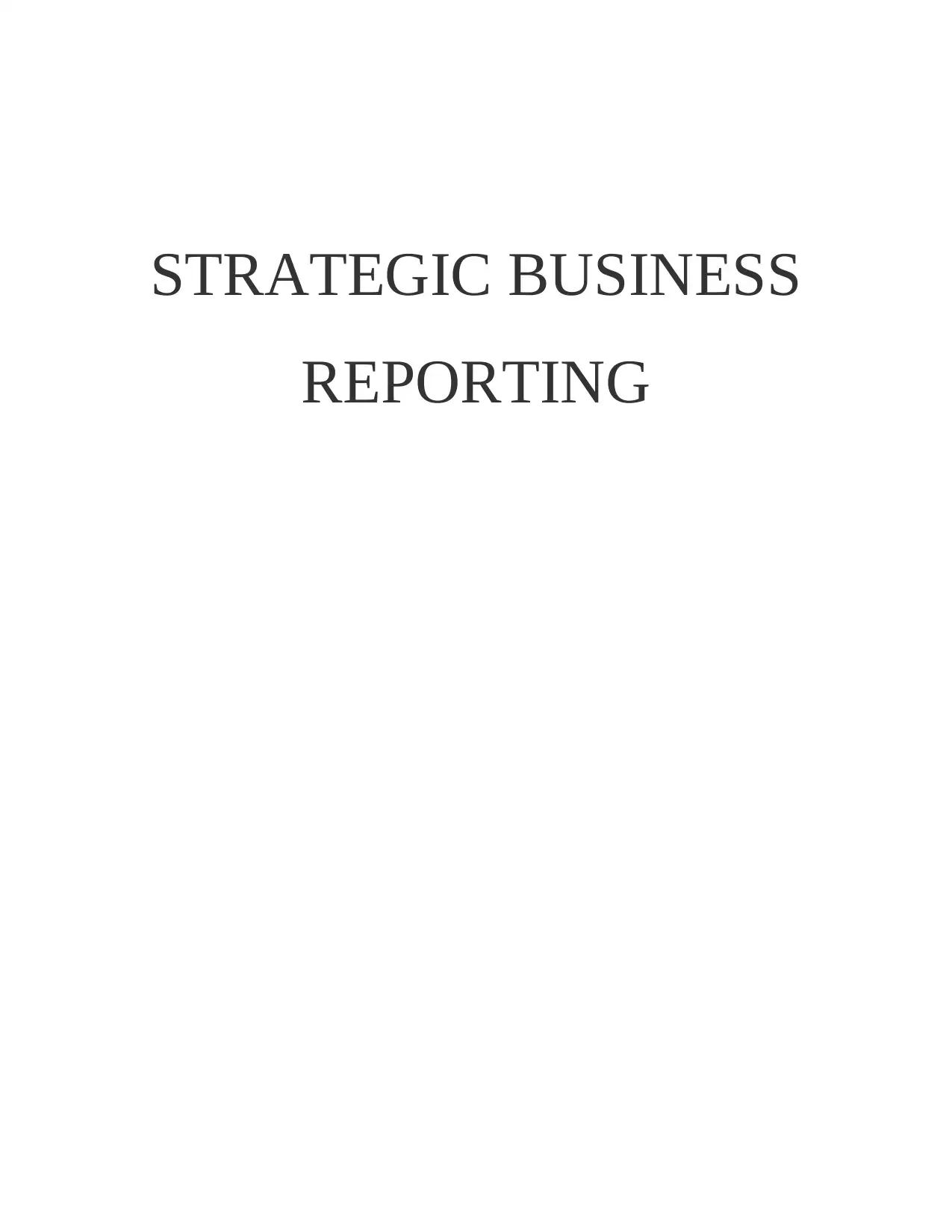
STRATEGIC BUSINESS
REPORTING
REPORTING
Paraphrase This Document
Need a fresh take? Get an instant paraphrase of this document with our AI Paraphraser
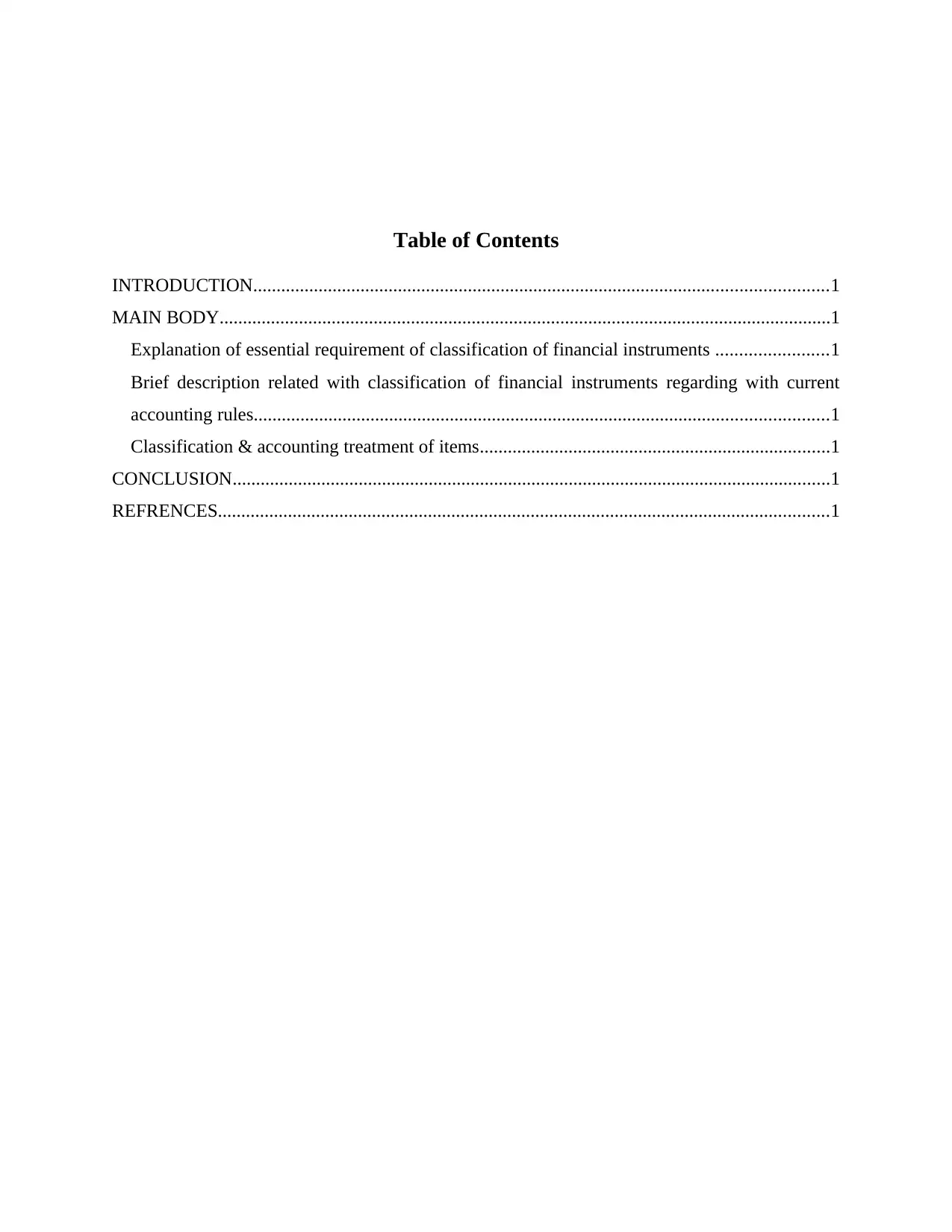
Table of Contents
INTRODUCTION...........................................................................................................................1
MAIN BODY...................................................................................................................................1
Explanation of essential requirement of classification of financial instruments ........................1
Brief description related with classification of financial instruments regarding with current
accounting rules...........................................................................................................................1
Classification & accounting treatment of items...........................................................................1
CONCLUSION................................................................................................................................1
REFRENCES...................................................................................................................................1
INTRODUCTION...........................................................................................................................1
MAIN BODY...................................................................................................................................1
Explanation of essential requirement of classification of financial instruments ........................1
Brief description related with classification of financial instruments regarding with current
accounting rules...........................................................................................................................1
Classification & accounting treatment of items...........................................................................1
CONCLUSION................................................................................................................................1
REFRENCES...................................................................................................................................1

⊘ This is a preview!⊘
Do you want full access?
Subscribe today to unlock all pages.

Trusted by 1+ million students worldwide
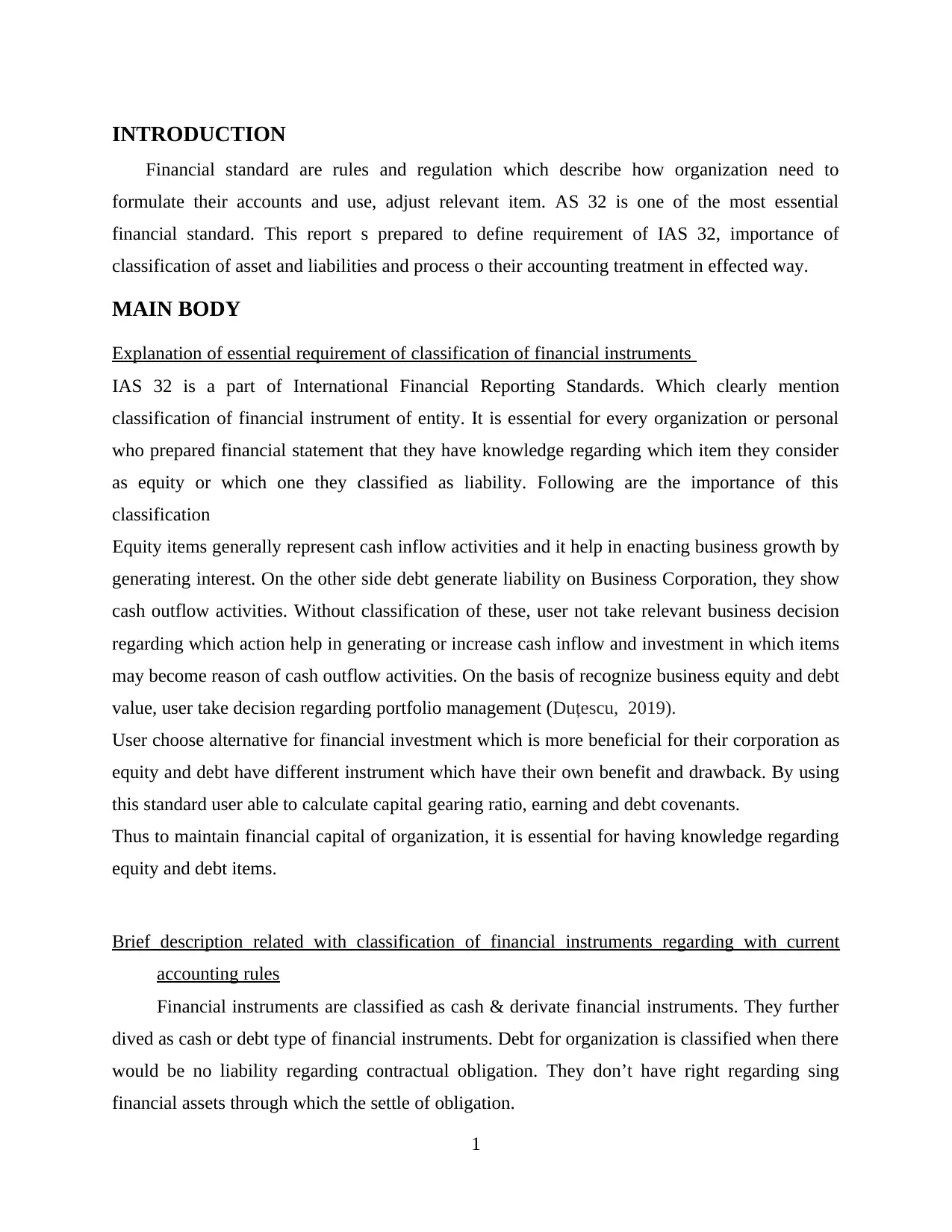
INTRODUCTION
Financial standard are rules and regulation which describe how organization need to
formulate their accounts and use, adjust relevant item. AS 32 is one of the most essential
financial standard. This report s prepared to define requirement of IAS 32, importance of
classification of asset and liabilities and process o their accounting treatment in effected way.
MAIN BODY
Explanation of essential requirement of classification of financial instruments
IAS 32 is a part of International Financial Reporting Standards. Which clearly mention
classification of financial instrument of entity. It is essential for every organization or personal
who prepared financial statement that they have knowledge regarding which item they consider
as equity or which one they classified as liability. Following are the importance of this
classification
Equity items generally represent cash inflow activities and it help in enacting business growth by
generating interest. On the other side debt generate liability on Business Corporation, they show
cash outflow activities. Without classification of these, user not take relevant business decision
regarding which action help in generating or increase cash inflow and investment in which items
may become reason of cash outflow activities. On the basis of recognize business equity and debt
value, user take decision regarding portfolio management (Duțescu, 2019).
User choose alternative for financial investment which is more beneficial for their corporation as
equity and debt have different instrument which have their own benefit and drawback. By using
this standard user able to calculate capital gearing ratio, earning and debt covenants.
Thus to maintain financial capital of organization, it is essential for having knowledge regarding
equity and debt items.
Brief description related with classification of financial instruments regarding with current
accounting rules
Financial instruments are classified as cash & derivate financial instruments. They further
dived as cash or debt type of financial instruments. Debt for organization is classified when there
would be no liability regarding contractual obligation. They don’t have right regarding sing
financial assets through which the settle of obligation.
1
Financial standard are rules and regulation which describe how organization need to
formulate their accounts and use, adjust relevant item. AS 32 is one of the most essential
financial standard. This report s prepared to define requirement of IAS 32, importance of
classification of asset and liabilities and process o their accounting treatment in effected way.
MAIN BODY
Explanation of essential requirement of classification of financial instruments
IAS 32 is a part of International Financial Reporting Standards. Which clearly mention
classification of financial instrument of entity. It is essential for every organization or personal
who prepared financial statement that they have knowledge regarding which item they consider
as equity or which one they classified as liability. Following are the importance of this
classification
Equity items generally represent cash inflow activities and it help in enacting business growth by
generating interest. On the other side debt generate liability on Business Corporation, they show
cash outflow activities. Without classification of these, user not take relevant business decision
regarding which action help in generating or increase cash inflow and investment in which items
may become reason of cash outflow activities. On the basis of recognize business equity and debt
value, user take decision regarding portfolio management (Duțescu, 2019).
User choose alternative for financial investment which is more beneficial for their corporation as
equity and debt have different instrument which have their own benefit and drawback. By using
this standard user able to calculate capital gearing ratio, earning and debt covenants.
Thus to maintain financial capital of organization, it is essential for having knowledge regarding
equity and debt items.
Brief description related with classification of financial instruments regarding with current
accounting rules
Financial instruments are classified as cash & derivate financial instruments. They further
dived as cash or debt type of financial instruments. Debt for organization is classified when there
would be no liability regarding contractual obligation. They don’t have right regarding sing
financial assets through which the settle of obligation.
1
Paraphrase This Document
Need a fresh take? Get an instant paraphrase of this document with our AI Paraphraser
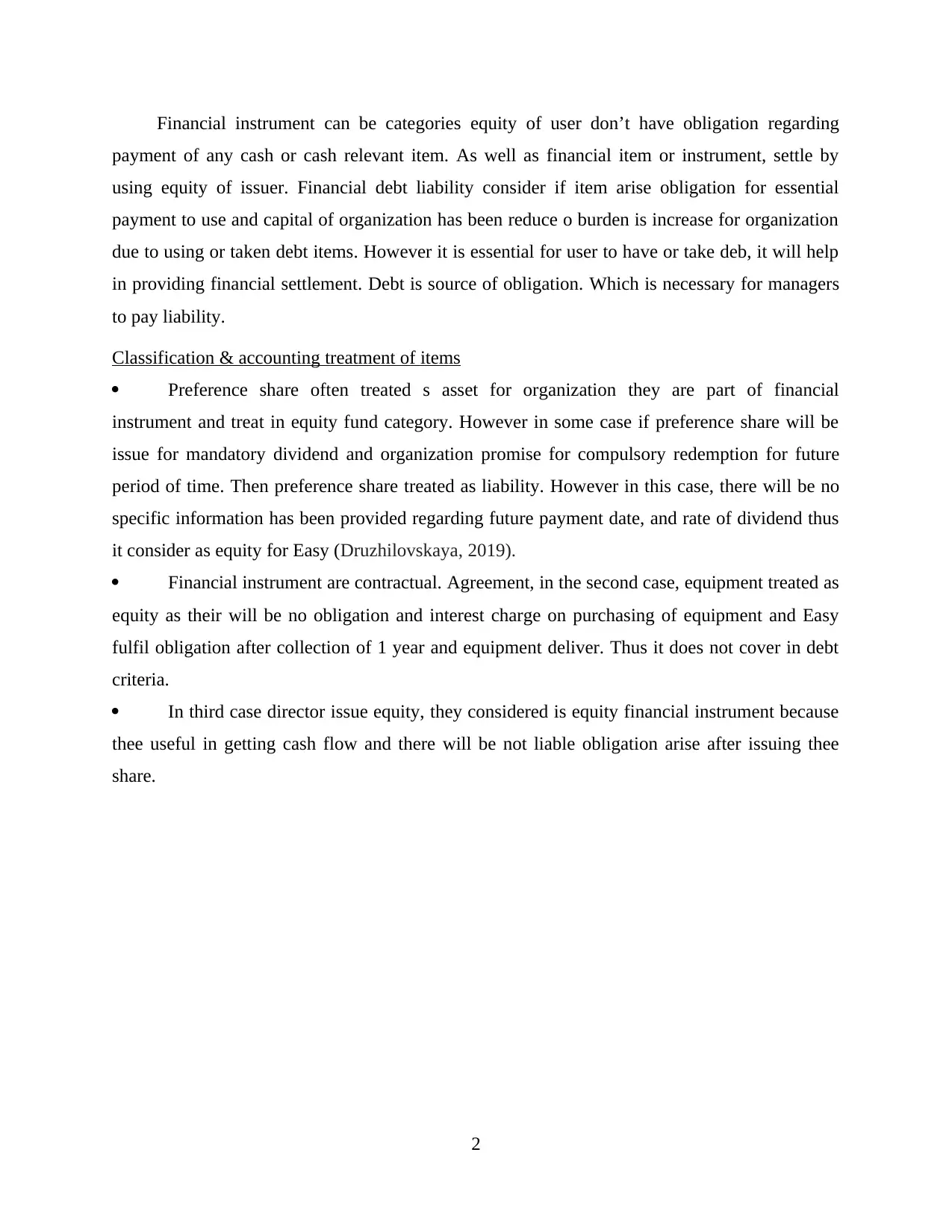
Financial instrument can be categories equity of user don’t have obligation regarding
payment of any cash or cash relevant item. As well as financial item or instrument, settle by
using equity of issuer. Financial debt liability consider if item arise obligation for essential
payment to use and capital of organization has been reduce o burden is increase for organization
due to using or taken debt items. However it is essential for user to have or take deb, it will help
in providing financial settlement. Debt is source of obligation. Which is necessary for managers
to pay liability.
Classification & accounting treatment of items
Preference share often treated s asset for organization they are part of financial
instrument and treat in equity fund category. However in some case if preference share will be
issue for mandatory dividend and organization promise for compulsory redemption for future
period of time. Then preference share treated as liability. However in this case, there will be no
specific information has been provided regarding future payment date, and rate of dividend thus
it consider as equity for Easy (Druzhilovskaya, 2019).
Financial instrument are contractual. Agreement, in the second case, equipment treated as
equity as their will be no obligation and interest charge on purchasing of equipment and Easy
fulfil obligation after collection of 1 year and equipment deliver. Thus it does not cover in debt
criteria.
In third case director issue equity, they considered is equity financial instrument because
thee useful in getting cash flow and there will be not liable obligation arise after issuing thee
share.
2
payment of any cash or cash relevant item. As well as financial item or instrument, settle by
using equity of issuer. Financial debt liability consider if item arise obligation for essential
payment to use and capital of organization has been reduce o burden is increase for organization
due to using or taken debt items. However it is essential for user to have or take deb, it will help
in providing financial settlement. Debt is source of obligation. Which is necessary for managers
to pay liability.
Classification & accounting treatment of items
Preference share often treated s asset for organization they are part of financial
instrument and treat in equity fund category. However in some case if preference share will be
issue for mandatory dividend and organization promise for compulsory redemption for future
period of time. Then preference share treated as liability. However in this case, there will be no
specific information has been provided regarding future payment date, and rate of dividend thus
it consider as equity for Easy (Druzhilovskaya, 2019).
Financial instrument are contractual. Agreement, in the second case, equipment treated as
equity as their will be no obligation and interest charge on purchasing of equipment and Easy
fulfil obligation after collection of 1 year and equipment deliver. Thus it does not cover in debt
criteria.
In third case director issue equity, they considered is equity financial instrument because
thee useful in getting cash flow and there will be not liable obligation arise after issuing thee
share.
2

CONCLUSION
From the above analyse it has been concluded that financial standard play essential role. As
by using these standards manager able to classified equity and debt which help in better decision
making process.
3
From the above analyse it has been concluded that financial standard play essential role. As
by using these standards manager able to classified equity and debt which help in better decision
making process.
3
⊘ This is a preview!⊘
Do you want full access?
Subscribe today to unlock all pages.

Trusted by 1+ million students worldwide
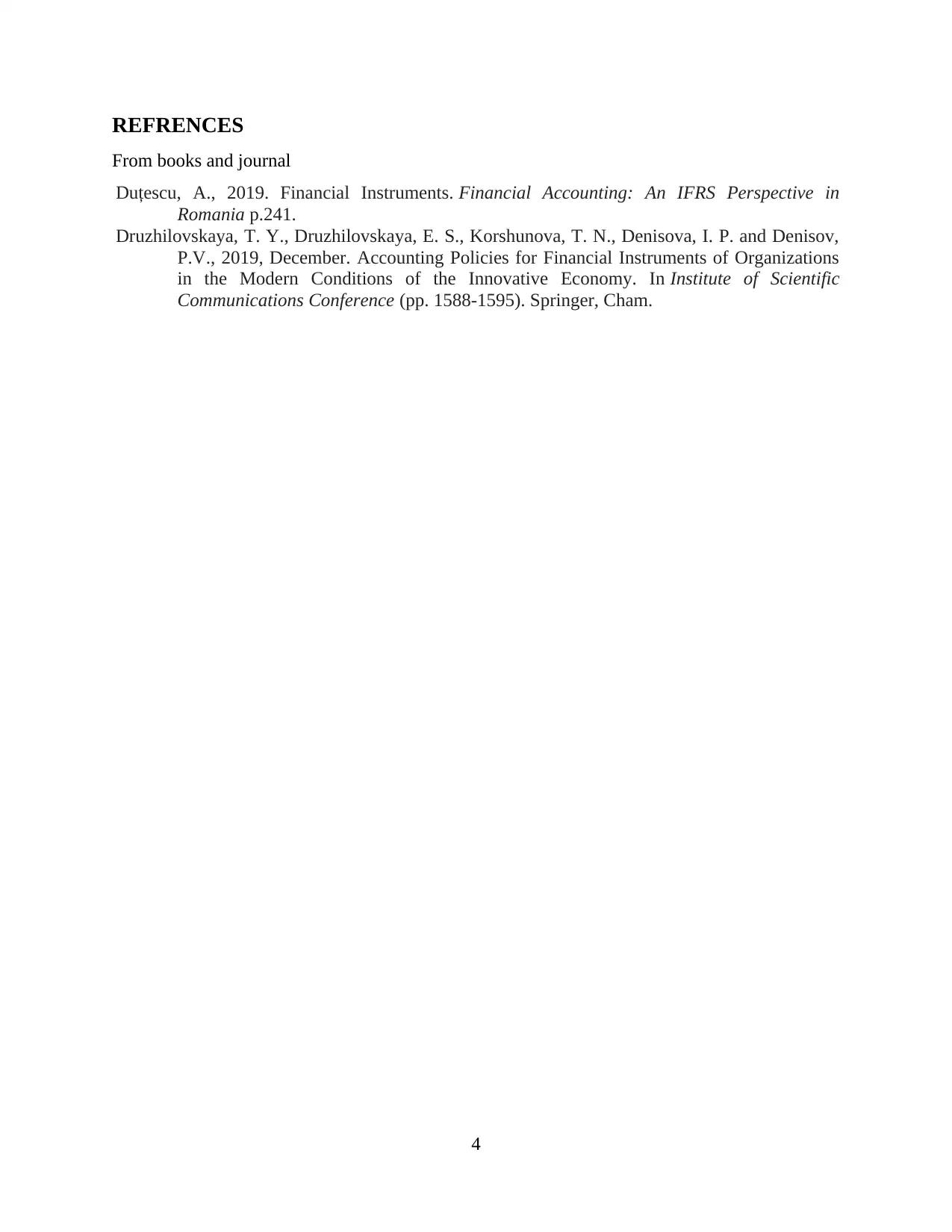
REFRENCES
From books and journal
Duțescu, A., 2019. Financial Instruments. Financial Accounting: An IFRS Perspective in
Romania p.241.
Druzhilovskaya, T. Y., Druzhilovskaya, E. S., Korshunova, T. N., Denisova, I. P. and Denisov,
P.V., 2019, December. Accounting Policies for Financial Instruments of Organizations
in the Modern Conditions of the Innovative Economy. In Institute of Scientific
Communications Conference (pp. 1588-1595). Springer, Cham.
4
From books and journal
Duțescu, A., 2019. Financial Instruments. Financial Accounting: An IFRS Perspective in
Romania p.241.
Druzhilovskaya, T. Y., Druzhilovskaya, E. S., Korshunova, T. N., Denisova, I. P. and Denisov,
P.V., 2019, December. Accounting Policies for Financial Instruments of Organizations
in the Modern Conditions of the Innovative Economy. In Institute of Scientific
Communications Conference (pp. 1588-1595). Springer, Cham.
4
1 out of 7
Related Documents
Your All-in-One AI-Powered Toolkit for Academic Success.
+13062052269
info@desklib.com
Available 24*7 on WhatsApp / Email
![[object Object]](/_next/static/media/star-bottom.7253800d.svg)
Unlock your academic potential
Copyright © 2020–2025 A2Z Services. All Rights Reserved. Developed and managed by ZUCOL.





